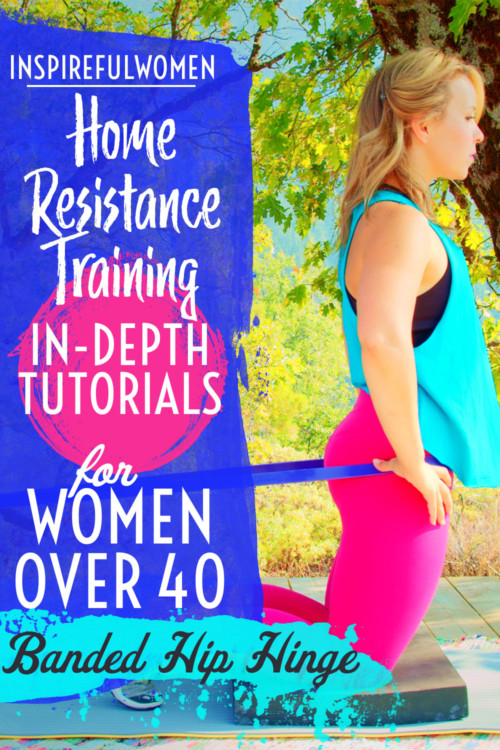Band Kneeling Hip Hinge
How to Do the Band Kneeling Hip Hinge - Glute Exercise | In-Depth Guide [VISUAL LEARNERS] Beginner
Proper Form, Common Mistakes, & Variations | Home Resistance Training
WHAT DO YOU WANT TO SEE?
QUICK DEMO
QUICK DEMO
MUSCLES THIS WORKS
MUSCLES
MAIN MUSCLES WORKED IN THE BAND KNEELING HIP HINGE
GLUTES & HAMSTRINGS
OTHER MUSCLES WORKED:
- LOW BACK
WHAT WE'RE DOING TODAY
WHAT & WHY
BENEFITS OF TRAINING OUR GLUTE & HAMSTRING MUSCLES
WHAT
WHAT WE'RE DOING TODAY
Other names for this exercise: Band hip hinge, Kneeling resisted hip hinge
We are doing something EXTREMELY functional today ladies - learning how to bend over properly so we don't hurt our backs. #weallneedthis #ifyoudontyouaintover40
ALL WE'RE DOING IS:
BENDING OVER AT THE HIPS, THEN COMING BACK UP.
Hip hinges are a foundational movement - meaning that learning how to hinge at the hips is essential in order to move through life with good form and keep your joints healthy.
When we bend over, the movement should be coming from our hips, not from our spine.
The Band Kneeling Hip Hinge is an easy effective exercise for strengthening the hips, glutes, and hamstrings while improving lower body mobility.
This is crucial for protecting our joints.
Our hip joints are large ball and socket joints, they are designed to move a lot. The joints of the spine are very small, they are designed for stability, a strong support beam for your arms and legs to move off of.
The hip hinge movement is a really good exercise for feeling the movement of the hips while keeping your spine still.
This exercise not only teaches you the right way to move, it strengthens the muscles on the back of your torso that help to hold you upright, with good posture, and it strengthens the muscles on the back of the pelvis and legs - the large gluteus maximus (buttock) muscle and the hamstrings.
When you fold at the hips, the movement is coming from the hips and the spine is held still.
Using a resistance band around the crease of the hip joint makes it easy to feel where the movement should be coming from.
This exercise not only teaches you the right way to move, it strengthens the muscles on the back of your torso that help to hold you upright, with good posture, and it strengthens the muscles on the back of the pelvis and legs - the large gluteus maximus (buttock) muscle and the hamstrings.
WHY BOTHER DOING IT?
WHY
WHY DO WE EVEN CARE?
TRAINS US HOW TO BEND OVER HEALTHFULLY IN EVERYDAY LIFE
This movement works the hip hinge pattern which is an incredibly functional activity because we do movements that involve this every single day - from picking objects up off the floor, unloading dishwashers, picking up toddlers, getting laundry out of the dryer, pots out of low cupboards.
IMPROVES SAFETY OF OTHER LOWER BODY EXERCISES
Learning how to do a hip hinge correctly is necessary for preventing injury during many other exercises. Practicing hinging at the hips will improve the safety of other movements in your exercise program, for example deadlifts, squats, lunges, step ups and hip thrusts. All of those movements should be done by hinging at the hips to avoid injuring your back. Hip hinges are exactly that - hinging at the hip joints. This is also true for many daily activities, for example, lifting a child up, squatting down for gardening, taking laundry out of the dryer.
HELPS US UNDERSTAND THE DIFFERENCE BETWEEN MOVEMENT AT THE HIPS AND MOVEMENT AT THE SPINE
A hip hinge is bending forward at the level of the hips, without other parts moving with it. It is a dissociation between movement at the low back vs movement at the hips.
For example, bending forward in the hip hinge, the torso moves downward by doesn’t round. The axis of rotation is occurring at the hips while the spine stays neutral. From an exercise standpoint, the hip hinge is an important component of the deadlift.
The hip is a huge ball and socket joint that is the second most mobile joint in the body - it is designed to move. Yet in our society we tend to lose mobility and strength in our hips and we move through our backs instead.
WORKS THE IMPORTANT MUSCLES OF THE POSTERIOR CHAIN
The kneeling hip hinge exercise works with what is often referred to as the posterior chain. The posterior chain includes all the muscles down the length of your backside and is the linkage and interdependence among the muscles of the backside body parts. Most notably, the posterior chain includes the gluteal muscles and the hamstrings. Together, these two large muscle groups help to extend the hips which is the main focus of this exercise.
The muscles of the lumbar spine (such as the lumbar paraspinals), also could be grouped in with the posterior chain, because they help to extend the trunk/low back.
EVERYDAY LIFE
EVERYDAY LIFE &
MUSCLE FUNCTION
HOW WE USE OUR GLUTES & HAMSTRINGS IN EVERYDAY LIFE
1. STRAIGHTENING THE HIP (EXTENSION)
Coming from a non-educated exercise background, I really didn't get what extending the hip or straightening the hip even meant. The way I finally "got it" was realizing it's when you go from a crease at your hips to no crease, or even pushing little further past no crease - thrusting the hips forward further so that the thigh starts to go behind the body.
- Walking
- Running
- Moving from sitting to standing
- From a chair
- Out of a car
- Off of the toilet
- Going up and down stairs
- Getting up from squatting
- Lifting from the floor
- Getting up from the floor
- Standing up from a bent over position
- Unloading a dishwasher/dryer
- Holds the body upright
- Standing
- Restraining/braking the pull of gravity on the upper body
- Leaning over - prevents the torso from being pulled down
The gluteus maximus lies on the back side of the pelvis. The hamstrings lie along the back of the thigh and attach (with the exception of the short head of the biceps femoris) to the bottom of the pelvis.
These muscles can pull the leg bone back from a forward position and slightly behind the body (which is called extension of the hip, or extending the hip).
PULLS UPPER BODY WHEN LEGS ARE STILL
The muscles can pull the leg back, or when the leg is stable (on the floor so it will not move) they can pull the upper body up - for example, if you are leaning to set something on a low coffee table and you stand back up again - the gluteus maximus helps to pull the body back to an upright position.
BRAKES FOR YOUR BODY
The muscles can also act as a brake, so as the weight of the upper body leans forward, gravity begins to pull it down. The gluteus maximus and hamstrings, along with the muscles of the back, prevent the body from falling forward.
HOW TO DO THE EXERCISE
LOOKS
HOW BANDED KNEELING HIP HINGE SHAPE OUR BODY
Defined hamstrings (back of the thighs) and will help shape a more round bottom.
PROPER FORM
PROPER FORM: BAND KNEELING HIP HINGE
EQUIPMENT, SETS & REPS
EQUIPMENT:
Loop Resistance Band
If that set is sold out, here is an Amazon search for the right type of bands (they're typically called pull up assist bands, but we're not using them for that):
Loop Resistance Band on Amazon
SUGGESTED STARTING WEIGHT FOR WOMEN:
Medium to heavy band resistance
SETS & REPS:
2-3 Sets of 8-10 Reps - if you get to the point where this feels too easy no matter what band you use, progress to the Glute Pull Through or the Hip Thrust.
PACE:
Interesting mix - the glutes are roughly split 50/50 of fast and slow-twitch fibers, but the hamstrings tend to be more fast-twitch dominant (upwards of 70%) - they can produce a lot of rapid force often seen in sprinting for example
BODY POSITION
BODY POSITION FOR THE BAND KNEELING HIP HINGE
BAND: Band mounted at hip level when on your knees, and placed in your hip crease on the other end.
The band should be anchored at about hip height. The band should be placed at the hip crease. The band shouldn’t be digging into the stomach region. Good landmarks to feel for are the two hip bones in the front of your body, where the lower abdominals meet the upper hip crease. These bony landmarks are known as the anterior superior iliac spine, or ASIS for short. Ideas:
- For lighter weight like a Theraband - tying a knot on one end and closing it in the door will also be a way to anchor it successfully
- A door anchor for band
- Looped around the leg of a heavy sofa or bookcase
- Mount a u-bolt or similar to the wall
HANDS: Standard position is hands resting on the hips. See arm position below for a slight variation
BODY STANCE: Neutral spine with head/neck/shoulders and hips in a stacked position (when in tall kneeling position). The beginning position will be what's called tall kneeling where your torso is upright, head stacked on shoulders stacked on hips stacked on knees. Adjust tension more or less as needed, depending upon the amount you need. This is the position where the resistance should be the strongest, where your glutes will really be working most.
FEET: Feet are flexed so that the big toe is bent and engaged with the ground.
ARMS: One alternative to hands on the hips is arms positioned directly out in front of the body at shoulder level. This can assist with bringing the body to the upright position against the band’s resistance, if necessary.
NECK: Neck and head in neutral position, lined up with the trunk
HOW TO DO
HOW TO DO THE BAND KNEELING HIP HINGE
CUE: Limit bending your knees as much as your body allows - the less you bend the knees the more glute & the less quad you will get.
- Engage your core by lightly bringing the belly button closer to the spine. This is not a rigid gripping of your core muscles, just a gentle activation.
- With the band in the appropriate position on your hips, begin the movement in a tall kneeling position, torso upright, shoulders stacked over hips stacked over knees.
- Hinge at the hips downwards so that your torso is parallel to the floor. If you cannot move your torso down that far without rounding your back, then lean over only as far as your back remains in neutral.
- Bring your body back to an upright, tall kneeling position by driving the hips forward, by squeezing through your glutes. This can be a fairly quick motion as the glutes are power muscles. The goal here is to get your hips into extension (not only NOT a crease in your hips, but you’re going for a minus crease in a sense haha!)
- Remember that this isn't about sitting backwards towards your heels - limit how much your knees bend during the movement as much as you can without falling over.
HOW TO SAFELY GET OUT OF THE EXERCISE
You may scoot on your knee backwards to take tension off the band. Take tension off the band by grabbing the band with your hands to lift it off your hips, and scoot backwards.
Another option is to stand up from there once you have the band secured in your hands. Then you can step out of the band and return to no tension.
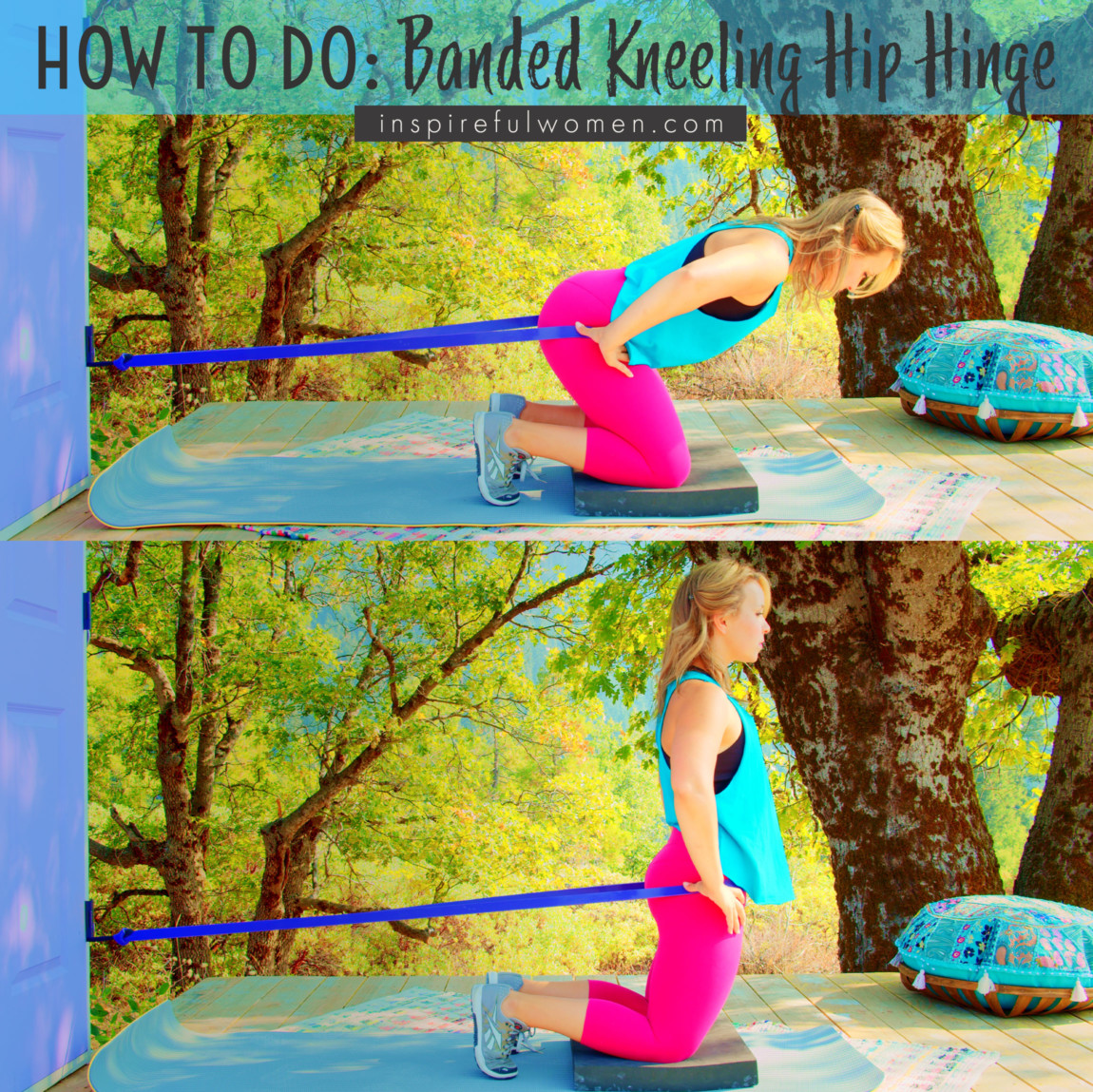
COMMON MISTAKES
COMMON MISTAKES
WHAT TO AVOID WITH THE BAND KNEELING HIP HINGE
KEY TIP:
Guess what? Good news! Many avoids are the same for most movements. Once you learn the basics, there's really only a few extra avoids for each individual movement.
1. Avoid Sitting Back On You Heels As You Lower
You are hingeing at the hips, so that your hips will go back a bit, but this is more about the goal of your upper torso and head coming forward/down as the trunk moves towards parallel to the floor.
If you end up mostly sitting back towards your heels while your torso is stays more upright or only slightly leaned over, this just won't work your glutes and hamstrings well.
So try to limit your knees bending a lot as you lower lower your torso - you'll have to bend them to SOME degree otherwise, as I demonstrate in the video, our top heavy position makes us just fall over! But the idea is to limit the knee bend as able.
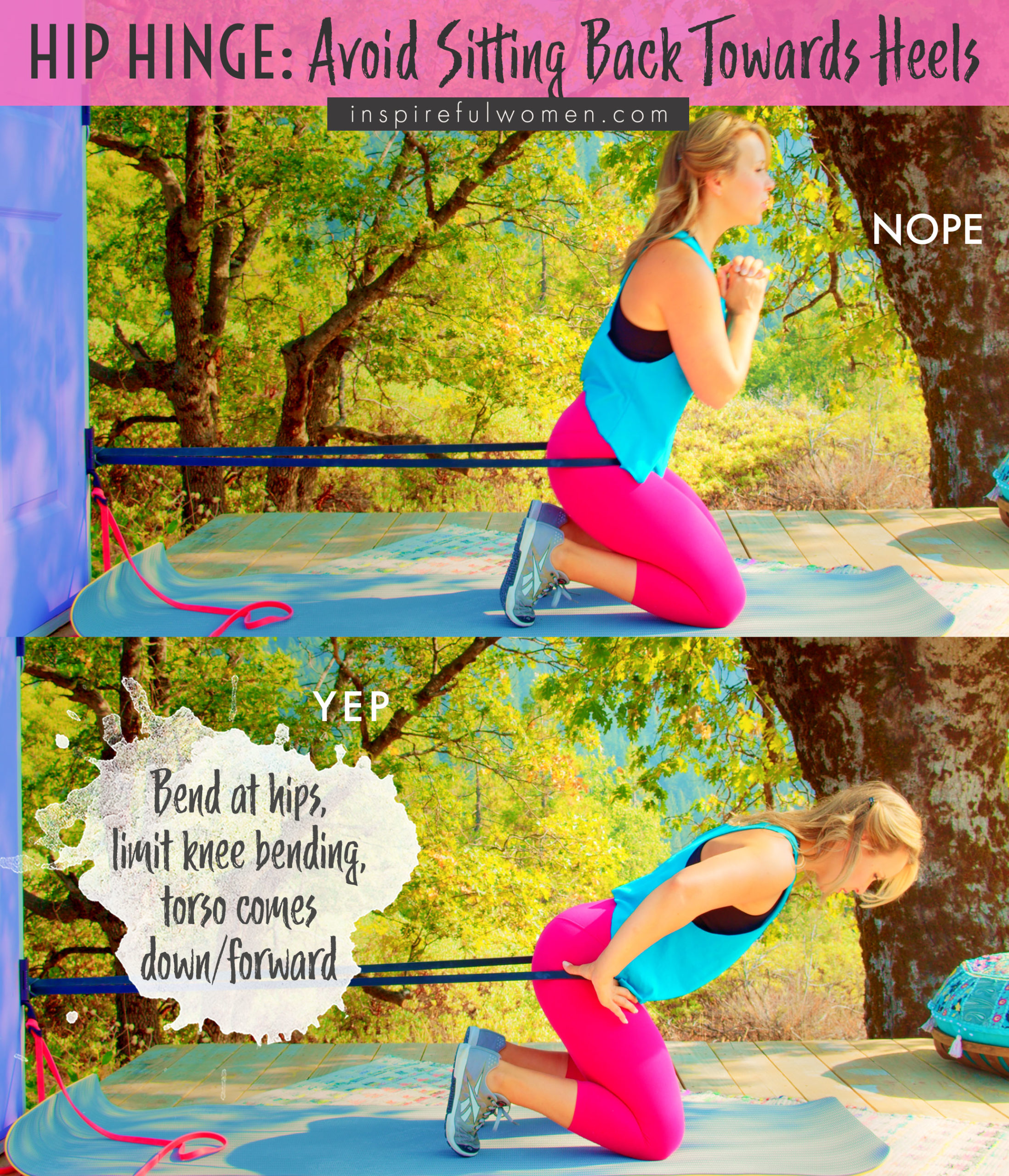
2. Avoid Excessively Rounding the Spine
Avoid excessively rounding the spine, especially the upper back (on the down). Repetitive motions like this puts stress on the spine. You want all bending and movement to come, not from the spine, but the hips where the glutes and hamstrings are doing the bulk of the work.
To make this happen, the muscles on your back, your back extensor muscles and scapular muscles of the upper back, need to be working. Many of us have not trained our back muscles much in the past (me included!), so you may need to lean your torso over LESS to begin with and as your muscle strength increases, you'll be able to lean over further without losing your neutral spine.
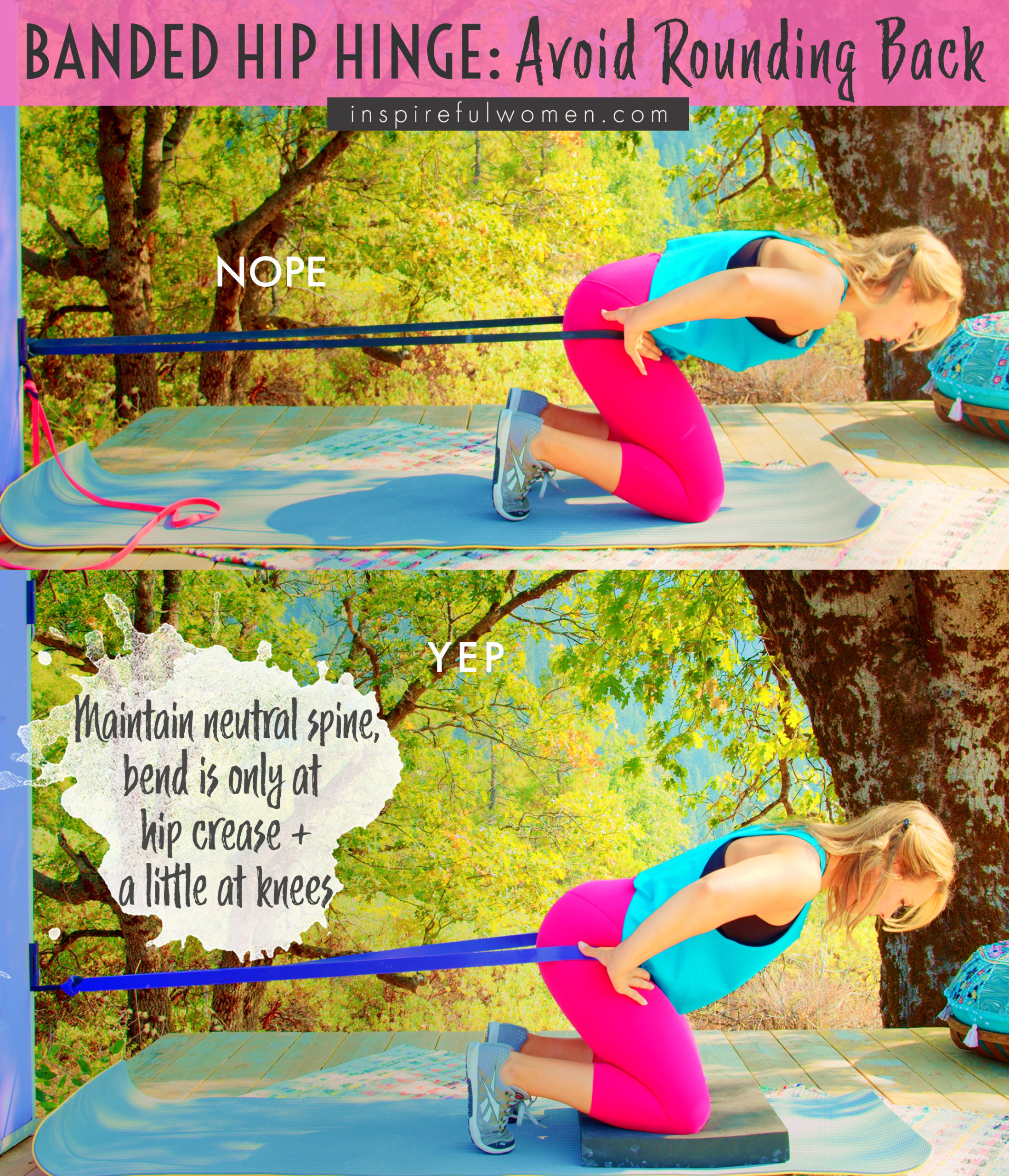
3. Avoid Arching Your Spine
Avoid hyperextending (arching) the low back (lumbar spine) as you move back up to the starting position. This will put stress on your lumbar spine and reduce the muscle activity of the glutes and hamstrings. Sometimes we might find ourselves inadvertently doing this as we push up our hips forward in a subconscious attempt to get more range of motion- but that movement would be coming from the wrong place - the spine, instead of the hips.
To avoid this, remember that you are trying to get most of your movement from the HIPS (along with a little bending/straightening of the knees), meaning that you want your spine to be still during the exercise.

4. Avoid Using Too Much Momentum
While in this movement a quick up is actually good and desirable to train these large glute muscles for power, using too much momentum to get into the tall kneeling position (thrusting hips forward with the arms out in front of you) is to be avoided - at that point momentum is what's achieving the movement instead of your muscles!
VARIATIONS
VARIATIONS
VARIATIONS OF THE BAND KNEELING HIP HINGE
LEANING HIP HINGE
Leaning Resistance Band Hip Hinge
Rather than the top of movement being straight up and down from knees to head, your entire body is leaned forward at the top - this makes it much harder and will work your core a lot more. That may be needed depending on your current strength in order to really fatigue the glute muscles with this movement at home, since they are large muscles, it often takes more resistance to fatigue them.
What I also found though is that in some cases this might be the only way to successfully do the movement if you need a stronger resistance band to really challenge you, because the straight up and down position can cause the mat to start sliding backward.
When doing this you need to keep your spine neutral, usually activating the abdominals a bit will do the trick. You are able to maintain a neutral spine and lean, as long as the leaning is coming from the knees, not by bending the spine.

VARY HOW FAR APART YOUR KNEES ARE
Vary Stance Width
- WIDER KNEELING STANCE - bringing your knees further apart will influence more of the inner thigh muscles (adductors)
- NARROW KNEELING STANCE - bringing your knees closer together is a less stable position for the body and will work your stabilizing muscles more.
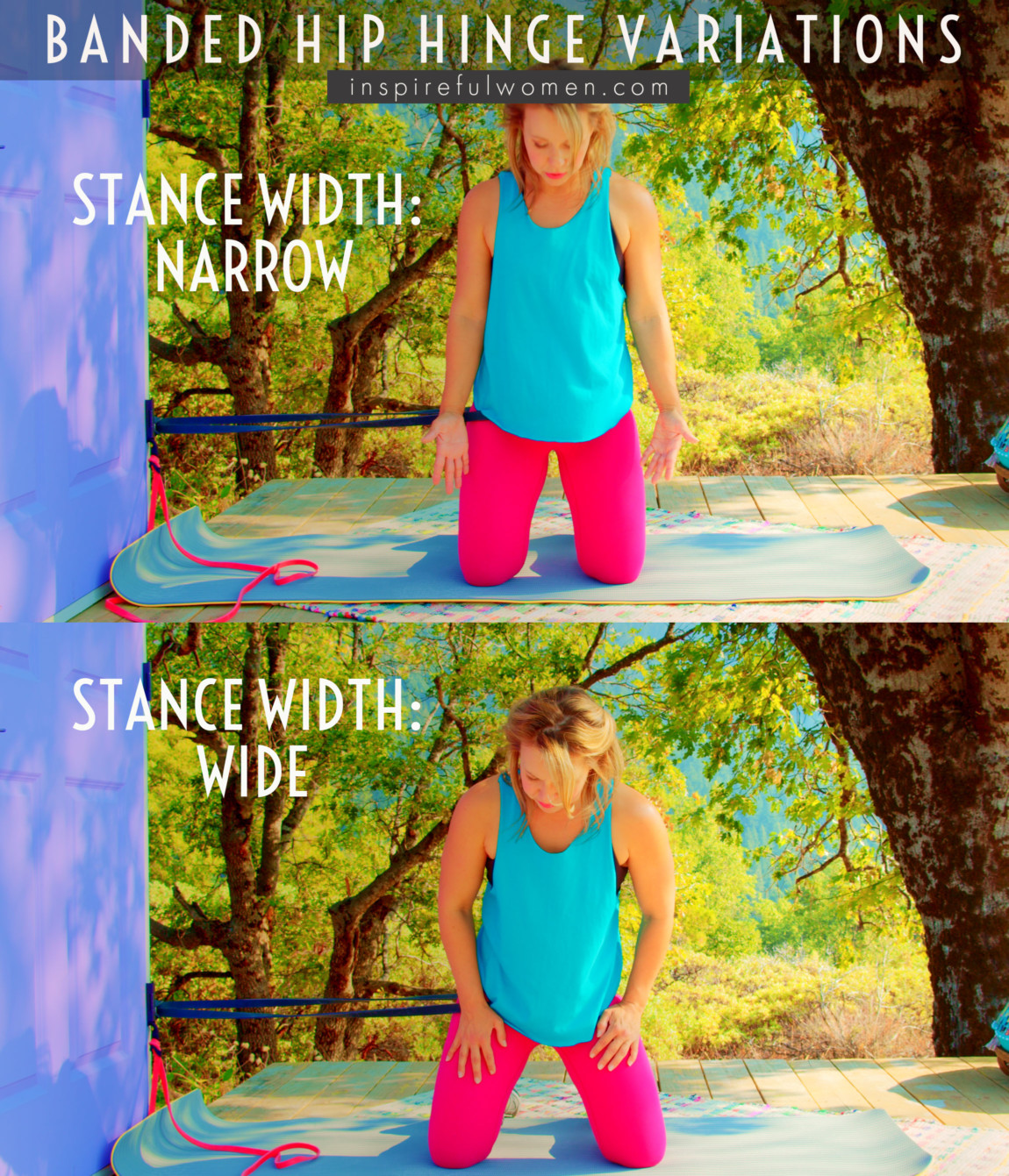
flexed or pointed feet
Feet Placement Options - Flexed or Pointed
Your toes can be pointed downward (tops of feet on the floor) if needed, if you find your toes bent to be uncomfortable. I actually strained my big toe once (who does that??) and I couldn't really bend it, especially with any weight on it (like my entire body pressing down on it!) for several months, it took a long time to heal. Additionally having your feet with your toes pointed can put less pressure on your knee joints.
The only difference with having your feet plantar flexed as you see here is I find it a little harder to not fall forward when I'm not able to dig my toes into the ground to help stabilize me, but you can compensate in other ways by leaning over less, etc.
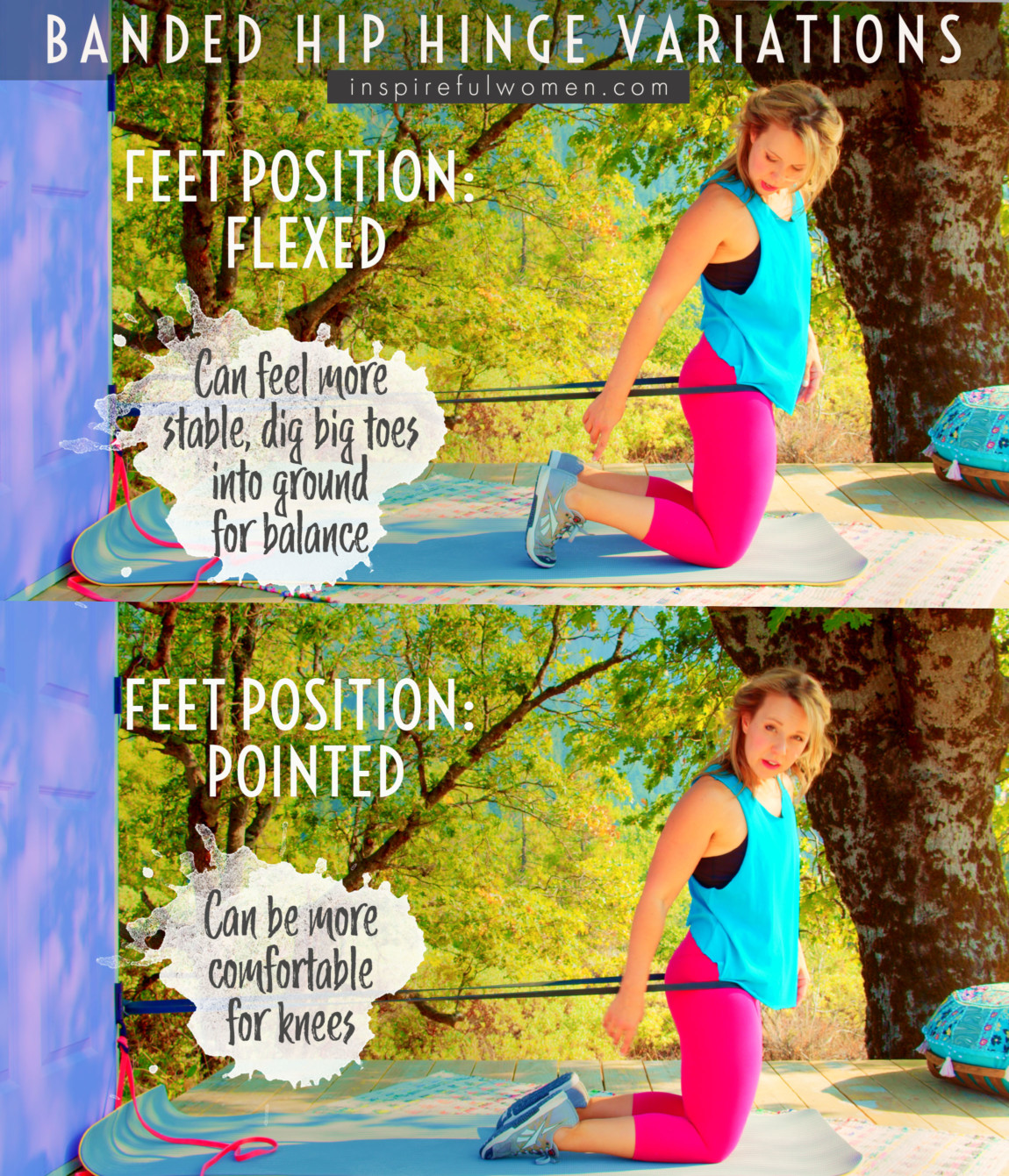
MAKE IT HARDER
HARDER
MAKING THE BAND KNEELING HIP HINGE MORE CHALLENGING
DOUBLE UP LIGHTER BANDS
Double Up Lighter Bands
One issue I run into a lot with these loop bands is that one becomes too light, while the next band up is too strong! Annoying. I seriously think they make most fitness equipment for the male musculature.
So to get around this, two ways to increase your resistance without using the the next band that's too strong is:
1. Get more tension with your current band by walking it away from where it is anchored and/or
2. Use 2 lighter bands together to gradually increase the resistance
These bands are pretty inexpensive so having a couple sets laying around can really be convenient.
DUMBBELL HELD IN FRONT
Dumbbell Held in Front
This variation holding a weight against your chest will pull the torso forward, working the back extensors, gluteus maximus and hamstrings more.
Hold a kettlebell or dumbbell in the goblet position, dumbbell held vertically, hands cupping the underside of the top black rubber. Hold the weight close to your chest.
Avoid rounding the shoulders, keep the sternum lifted and the chest open.

GLUTE PULL THROUGH
Glute Pull Through
Progress to a glute pull-through- you will be able to use a stronger resistance band and get a better/great contraction of the glute muscles.
My opinion is that once you are strong enough for the glute pull through, you probably just won't be doing the hip hinge anymore to fully fatigue the glute muscles.
The glute muscles are very large and strong, and once you are strong enough for the glute pull through, the kneeling hip hinge exercise I just can't seem to make hard enough to actually challenge my glute muscles.
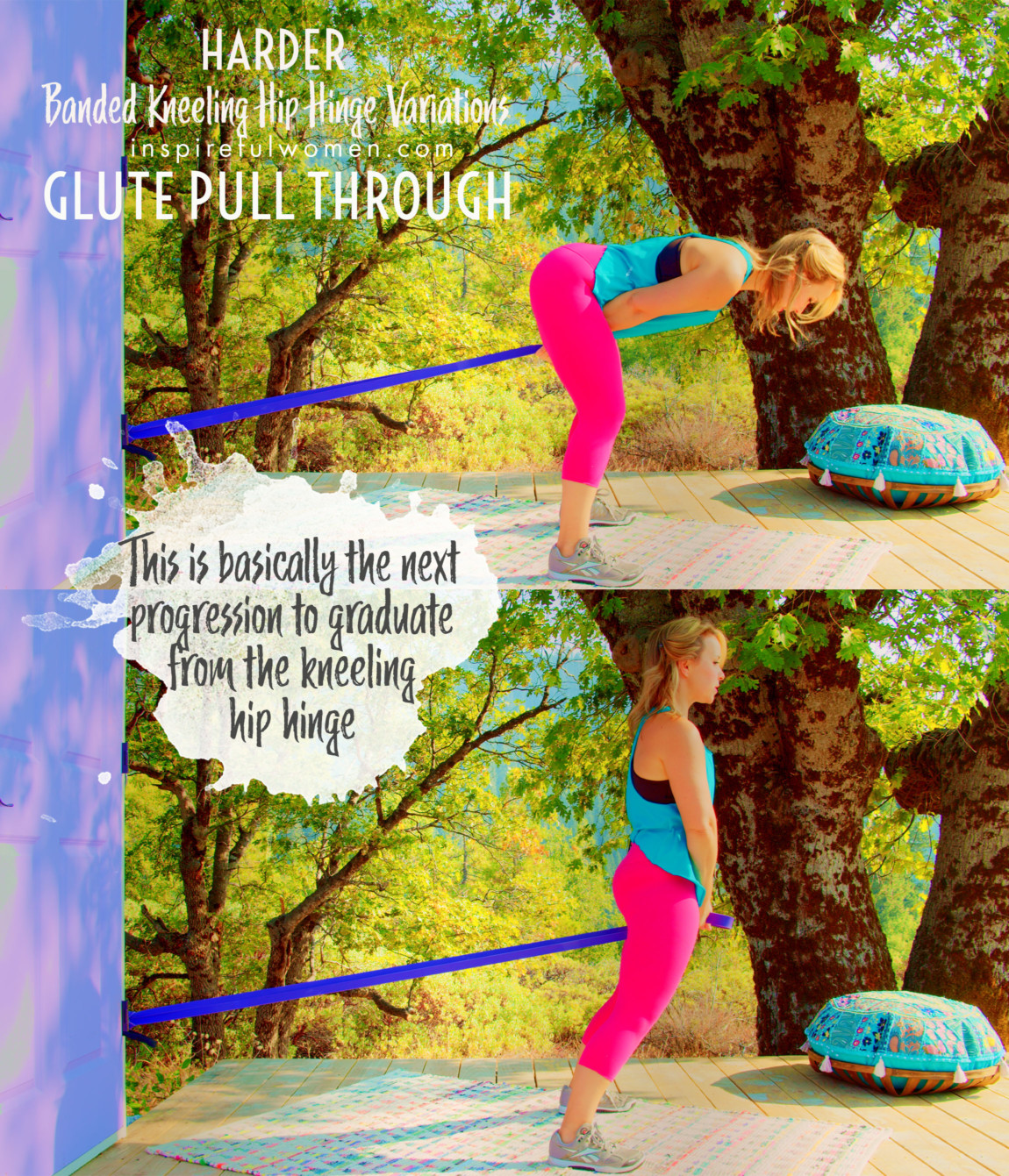
MAKE IT EASIER
EASIER
MAKE THE BAND KNEELING HIP HINGE MORE DOABLE
DO SLOWLY
Do More Slowly
Do the up portion of the movement more slowly to get a feel for the working muscles.
When we slow things down, we get a chance to more mindfully feel/think about what muscles should be working and getting in tune with that. Don't underestimate how helpful this can be in both learning how to do the movement correctly, AND working the intended muscles much more effectively.
HOLD DUMBBELL BEHIND YOU
Hold Dumbbell Behind You
This is a way to practice the kneeling hip hinge if you struggle with the weight of your torso kind of making you fall forward- the weight behind you will counterbalance you a bit so you can practice and learn the hip hinge movement.
This version will not work your glute muscles so much, but is more of a beginner way to get a feel for the movement.
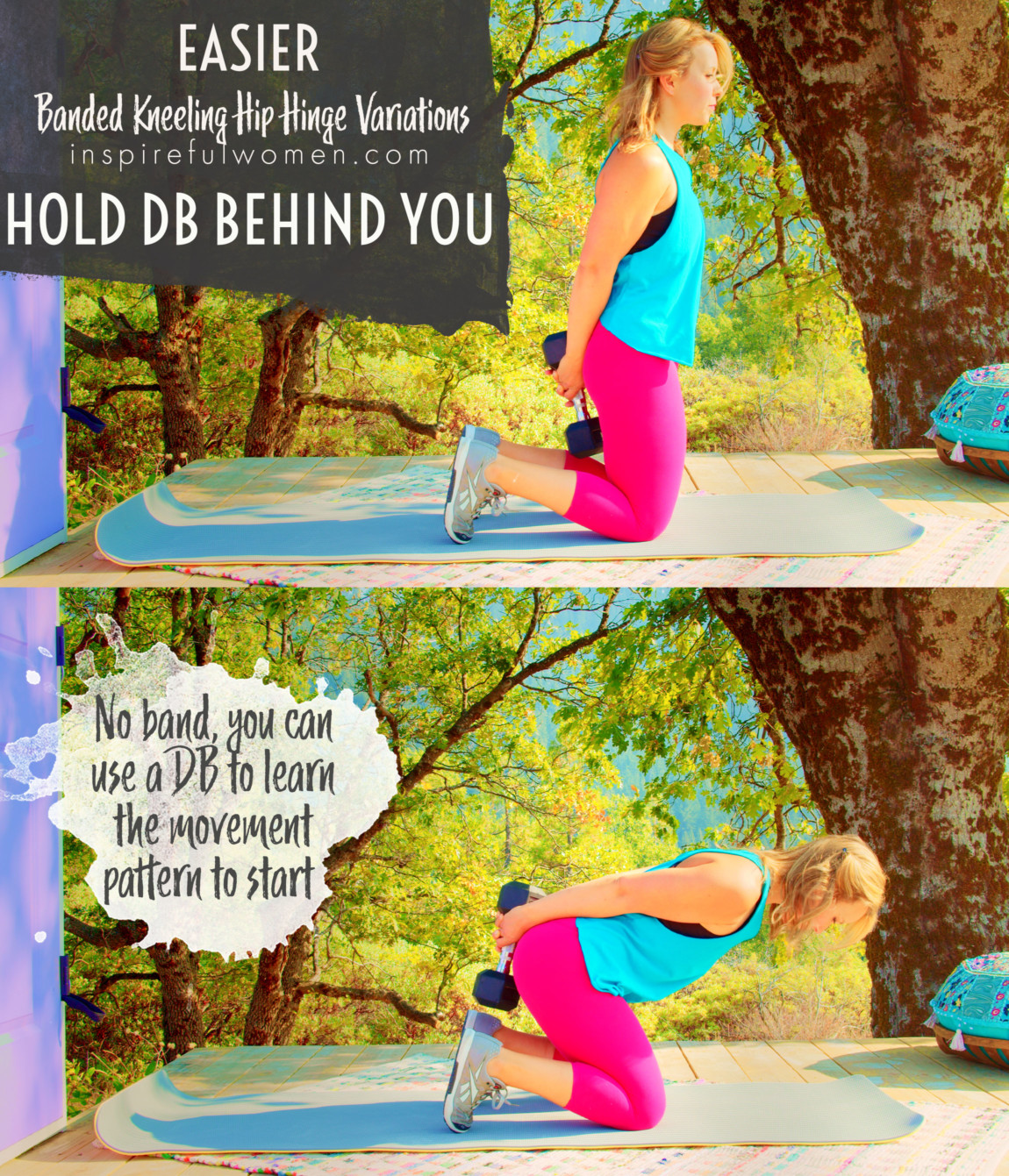
HANDS OUT FRONT
Hands Out Front
Arms positioned directly out in front of the body at shoulder level. This can assist with bringing the body to the upright position against the band’s resistance, if necessary. This can be done just with your hands, or holding a pair of light dumbbells.
TO DO THIS: At the top of the movement, hold either your hands or weights out in front of you, with your hands at the level of your shoulders. Then your arms move with the trunk, so they stay in line with your shouldesr when you hinge. Then at the top of the movement (hips extended) lift them up overhead and then back down to in line with your shoulders.
If you hold the weight right out in front of you (straight arms) as you hinge. Depending on the amount of weight that is used: the exercise may feel more stable but the gluteus maximus and hamstrings will need to work harder. The weight in front of you will act as a counter balance as the band pulls your hips back. As you pull the hips forward the hip extensors will work harder because the weight is pulling you forward and the hip extensors will have to move you back to upright. It will also work the core a bit more. Return to tall kneeling position (hip in neutral) and extend the arms up overhead.
Avoid arching your low back when you lift the arms overhead. Keep your abdominals engaged to keep the spine in a neutral position.
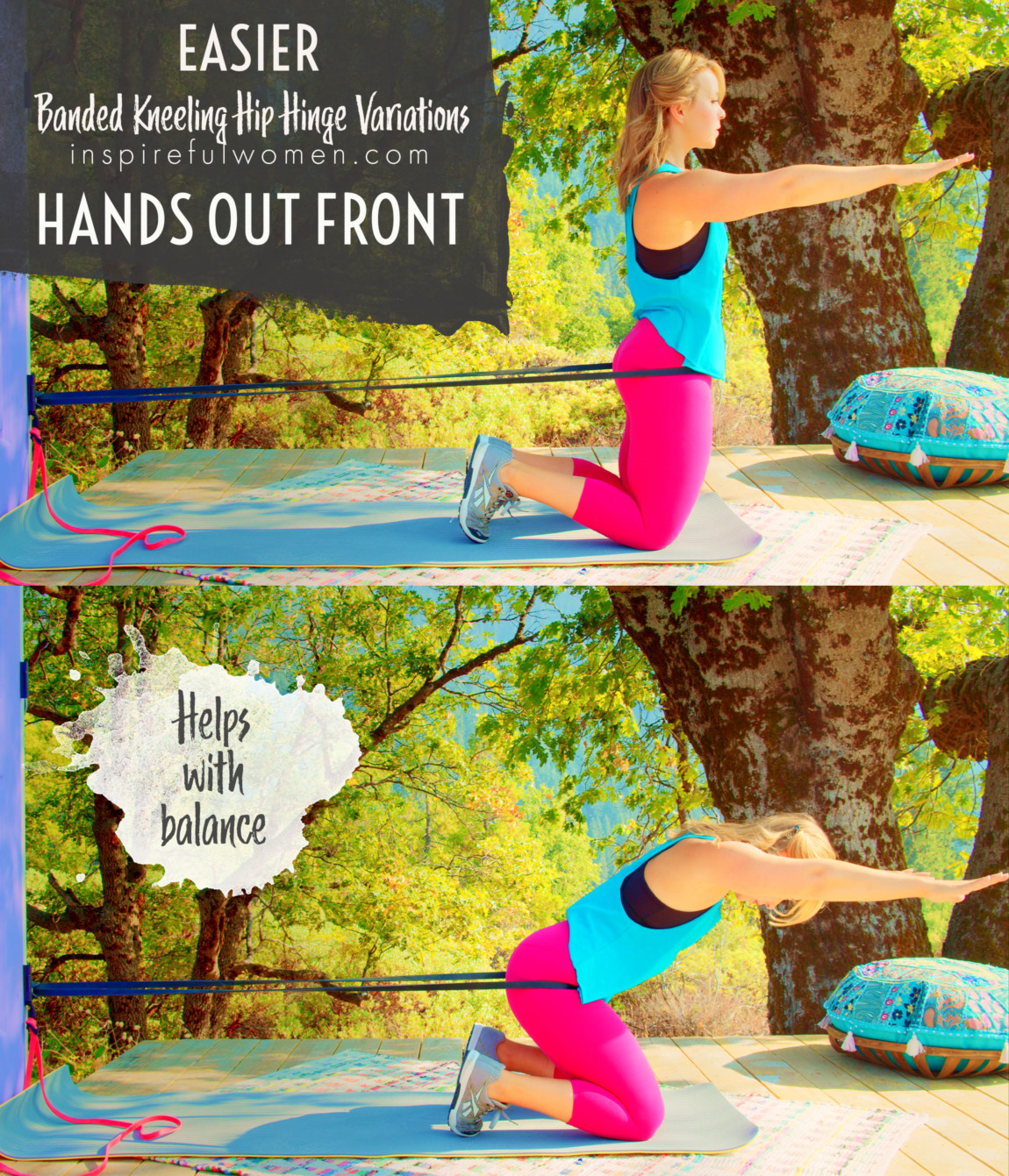
IF YOU'RE HAVING A HARD TIME:
To make sure you are moving properly for this exercise, first, start in a “proud chest” tall kneeling position by squeezing the shoulder blades back and bracing the core slightly. Try to bring your hips/buttocks back toward the back of your legs while maintaining these two areas as they are. You will inevitably have to hinge at your hips to continue in this way. If your back starts to round, you’ve lost that tension/stability created by the shoulder blades and the core.
How to practice only a portion of the movement to get familiar with it:
The hip hinge can be practiced in standing, which can help with this tall kneeling exercise. Stand 4-5 inches with your back to a wall. Perform the hip hinge movement but try to touch your buttocks to the wall. If your are bending and the buttocks touch the wall, this is the feedback that the movement is being performed correctly.
SCIENCY STUFF
SCIENCY STUFF
SPIFFILICIOUS FACTS ABOUT MUSCLES & MOVES
This exercise works what is often referred to as the posterior chain.
I used to think the posterior chain muscles were only the muscles on the back of your lower half- the booty down. Come to find out, the posterior chain includes ALL the muscles down the length of your backside, from the head to your feet basically and is the linkage and interdependence among the muscles of the backside body parts. Most notably, the posterior chain includes the gluteal muscles and the hamstrings. Together, these two large muscle groups help to extend the hips which is the main focus of this exercise.
The muscles of the lumbar spine (such as the lumbar paraspinals), also could be grouped in with the posterior chain, because they help to extend the trunk/low back.
THE GLUTE MAX
The gluteus maximus is a large fan shaped muscle that lies on the back side of your pelvis.
The main function of the gluteus maximus is to move the thigh bone (femur) back behind the body.
The muscle also works to control the movement of the upper body when you lean over. The muscle acts as a brake, so as the weight of the upper body leans forward, gravity begins to pull it down. The gluteal muscles along with other muscles of the torso and legs, prevent the body from falling forward.
THE HAMSTRINGS
There are 3 hamstring muscles, the biceps femoris, semimembranosus and semitendinosus. The muscles (with the exception of the short head of the biceps femoris) originate on the Sitz bones and attach on the lower leg. They can:
extend the thigh (move back from a bent position) and
they can extend the knee (straighten the knee)
The hamstring muscles work with the gluteus maximus in straightening up from a bending position. The hamstrings are responsible for about ⅓ to ½ of the effort.
ALL MUSCLES & WHEN
ALL MUSCLES WORKING & WHEN DURING THE BAND KNEELING HIP HINGE
The tall kneeling hip hinge can be divided into two phases - the eccentric and concentric phases (like all exercises).
- The eccentric phase is the controlled lengthening of the muscles as you sit your bottom back toward the heels. This is where you’ll feel a stretch in the hamstrings.
- The concentric phase is the contraction or shortening of the glutes and hamstring as you lift the torso upright and push the hips forward in the kneeling position.
The idea of a hip hinge is to move between hip flexion (creasing of the hip) and hip extension) (getting rid of the crease in the hip!) while keeping your spine in neutral the entire time.
One trick about this that is often not understood is that in most hip hinge exercises it’s less about knee movement, and more focus just at the hips - there is some knee movement, but not a lot and most of the movement is occurring at the hips.
This means that your torso will actually be bending over/downward, something we often think we aren’t supposed to do (and when you are rounding the back in bending, that is true that’s to be avoided), but when the bend comes directly from the hips and not the back, this is a very healthy and functional movement pattern. This is different from a squat movement that uses more knee bending causing your torso to move more vertically downwards and less bending over.
PIN IT FOR LATER!

